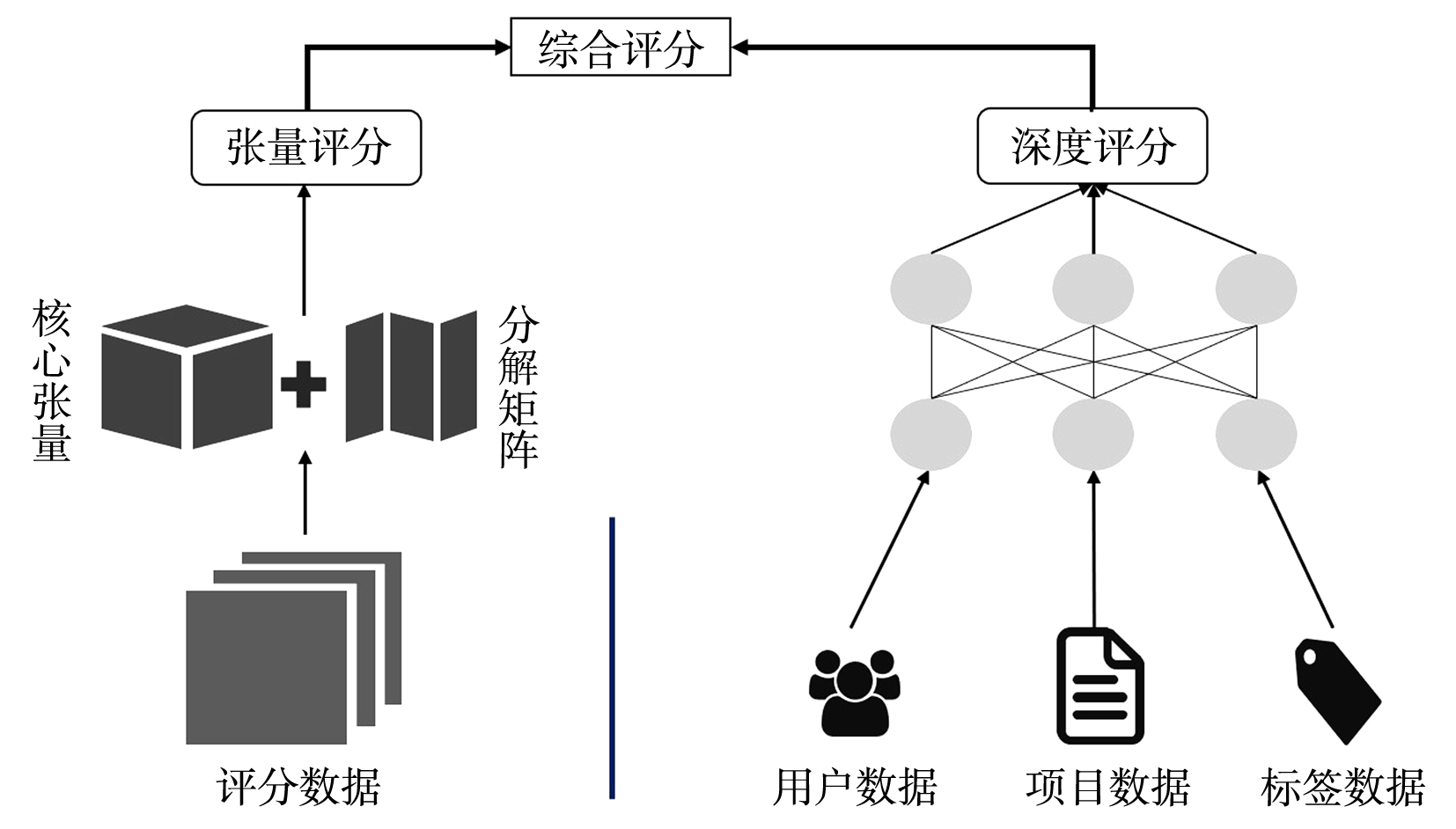南京大学学报(自然科学版) ›› 2019, Vol. 55 ›› Issue (6): 952–959.doi: 10.13232/j.cnki.jnju.2019.06.008
基于张量分解和深度学习的混合推荐算法
- 1. 安徽建筑大学数理学院,合肥,230601
2. 安徽建筑大学电子与信息学院,合肥,230601
3. 安徽建筑大学机械与电气工程学院,合肥,230601
4. 福建师范大学数学与信息学院,福州,350007
Blending recommendation algorithm based ontensor decompositions and deep learning
Jiajing Zhang1,Xunpeng Xia2( ),Jinlan Chen3,Youcong Ni4
),Jinlan Chen3,Youcong Ni4
- 1. School of Mathematics & Physics,Anhui Jianzhu University,Hefei,230601,China
2. School of Electronics and Information,Anhui Jianzhu University,Hefei,230601,China
3. School of Mechanical and Electrical Engineering,Anhui Jianzhu University,Hefei,230601,China
4. School of Math and Information Science,Fujian Normal University,Fuzhou,350007,China
摘要:
张量分解和深度学习已被应用于推荐系统,并取得了较好的效果.张量分解较好地从用户对推荐对象评分中提取用户、推荐对象以及其他影响因素的隐性的特征,将这些特征进行匹配,给出推荐策略,但这种方法忽略了用户、推荐对象以及其他影响因素现有辅助数据信息中的显性特征.深度学习是从辅助信息中提取用户、推荐对象以及其他影响因素的特征,并进行匹配给出推荐策略,却忽略了用户评分数据中用户、推荐对象以及其他影响因素的隐性特征.将张量分解和深度学习两种推荐方法相融合,提出一种基于张量分解和深度学习的混合推荐算法.使用张量分解算法和深度学习分别从三阶用户评分数据和多源异构辅助信息中提取用户特征和推荐对象特征,并将它们匹配得出用户对推荐对象的需求或喜爱的预测评分,再将两种算法的预测评分进行融合给出最终综合评分,从而提高个性化推荐的精准度.对比实验证明混合推荐算法与传统的协同过滤算法相比误差降低了34.0%.
中图分类号:
- TP393
| 1 | Ramondt S , Ramírez A S . Assessing the impact of the public nutrition information environment:adapting the cancer information overload scale to measure diet information overload. Patient Education and Counseling,2018,102(1):37-42. |
| 2 | 黄丹 . 基于张量分解的推荐算法研究. 硕士学位论文. 北京:北京交通大学,2016.(Hang D. Research on tensor factorization?based recommendation algorithm. Master Dissertation. Beijing:Beijing Jiaotong Universty,2016.) |
| 3 | 刘凯鹏,方滨兴 . 一种基于社会性标注的网页排序算法. 计算机学报,2010,33(6):1014-1023.(Liu K P,Fang B X. A novel page ranking algorithm based on social annotations. Chinese Journal of Computers,2010,33(6):1014-1023.) |
| 4 |
Zhang Z K , Liu C . Hypergraph model of social tagging network. Journal of Statistical Mechanics Theory and Experiment,2010,doi:10.1088/1742?5468/2010/10/P10005 .
doi: 10.1088/1742?5468/2010/10/P10005 |
| 5 | Hofmann T . Latent semantic models for collaborative filtering. ACM Transactions on Information Systems,2004,22(1):89-115. |
| 6 | Sarwar B , Karypis G , Konstan J ,et al . Item?based collaborative filtering recommendation algorithms∥Proceedings of the 10th International Conference on World Wide Web. Hong Kong,China:ACM,2001,doi:10.1145/371920.372071. |
| 7 | Guo H F , Tang R M , Ye Y M ,et al . DeepFM:a factorization?machine based neural network for CTR prediction∥Proceedings of the 26th International Joint Conference on Artificial Intelligence. Melbourne,Australia:IJCAI,2017,doi:10.24963/ijcai.2017/239. |
| 8 | Pan R , Dolog P , Xu G . KNN?based clustering for improving social recommender systems∥Cao L,Zeng Y,Symeonidis A L, et al . Agents and Data Mining Interaction. Springer Berlin Heidelberg,2012,doi:10.1007/978?3?642?36288?0_11. |
| 9 | Liao H , Mcdermott E , Senior A . Large scale deep neural network acoustic modeling with semi?supervised training data for Youtube video trans?cription∥2013 IEEE Workshop on Automatic Speech Recognition and Understanding. Olomouc,Czech Republic:IEEE,2013,doi:10.1109/ASRU.2013.6707758. |
| 10 | 邓腾飞 . 个性化音乐推荐系统的研究. 硕士学位论文. 广州:华南理工大学,2018.(Deng T F. Research of personalized music recommender system. Master Dissertation. Guangzhou:South China University of Technology,2018.) |
| 11 | Symeonidis P , Nanopoulos A , Manolopoulos Y . Tag recommendations based on tensor dimen?sionality reduction∥Proceedings of the 2008 ACM Conference on Recommender Systems. Lausanne,Switzerland:ACM,2008:43-50. |
| 12 | Rendle S , Schmidt?Thieme L . Pairwise interaction tensor factorization for personalized tag recommen?dation∥Proceedings of the 3rd ACM International Conference on Web Search and Data Mining. New York,NY,USA:ACM,2010:81-90. |
| 13 | Hsieh C K , Yang L , Cui Y ,et al . Collaborative metric learning∥Proceedings of the 26th Inter?national Conference on World Wide Web. Perth,Australia:International World Wide Web Conferences Steering Committee,2017:193-201. |
| 14 | 黄立威,江碧涛,吕守业 等 . 基于深度学习的推荐系统研究综述. 计算机学报,2018,41(7):1619-1647. |
| Huang L W , Jiang B T , Lv S Y ,et al . Survey on deep learning based recommender systems. Chinese Journal of Computers,2018,41(7):1619-1647. | |
| 15 | 廖志芳,李玲,刘丽敏 等 . 三部图张量分解标签推荐算法. 计算机学报,2012,35(12):2625-2632. |
| Liao Z F , Li L , Liu L M ,et al . A tripartite decomposition of tensor for social tagging. Chinese Journal of Computers,2012,35(12):2625-2632. | |
| 16 | Ross I M . An optimal control theory for nonlinear optimization. Journal of Computational and Applied Mathematics,2019,354:39-51. |
| 17 | Hernando A , Bobadilla J , Ortega F . A non negative matrix factorization for collaborative filtering recommender systems based on a Bayesian probabilistic model. Knowledge?Based Systems,2016,97:188-202. |
| 18 | Spiegelberg J , Rusz J , Pelckmans K . Tensor decompositions for the analysis of atomic resolution electron energy loss spectra. Ultramicroscopy,2017,175:36-45. |
| [1] | 朱伟,张帅,辛晓燕,李文飞,王骏,张建,王炜. 结合区域检测和注意力机制的胸片自动定位与识别[J]. 南京大学学报(自然科学版), 2020, 56(4): 591-600. |
| [2] | 李康,谢宁,李旭,谭凯. 基于卷积神经网络和几何优化的统计染色体核型分析方法[J]. 南京大学学报(自然科学版), 2020, 56(1): 116-124. |
| [3] | 韩普,刘亦卓,李晓艳. 基于深度学习和多特征融合的中文电子病历实体识别研究[J]. 南京大学学报(自然科学版), 2019, 55(6): 942-951. |
| [4] | 钟琪,冯亚琴,王蔚. 跨语言语料库的语音情感识别对比研究[J]. 南京大学学报(自然科学版), 2019, 55(5): 765-773. |
| [5] | 王蔚, 胡婷婷, 冯亚琴. 基于深度学习的自然与表演语音情感识别[J]. 南京大学学报(自然科学版), 2019, 55(4): 660-666. |
| [6] | 聂秀山1,4,王舒婷1,尹义龙2,3*. 基于特征融合和曼哈顿量化的视频哈希学习方法[J]. 南京大学学报(自然科学版), 2016, 52(4): 705-. |
| [7] | 张鹏,黄毅,阮雅端,陈启美*. 基于稀疏特征的交通流视频检测算法[J]. 南京大学学报(自然科学版), 2015, 51(2): 264-270. |
| [8] | 曾奎1, 何丽芳2, 杨晓伟1. 基于多线性主成分分析的支持高阶张量机[J]. 南京大学学报(自然科学版), 2014, 50(2): 219-. |
|














